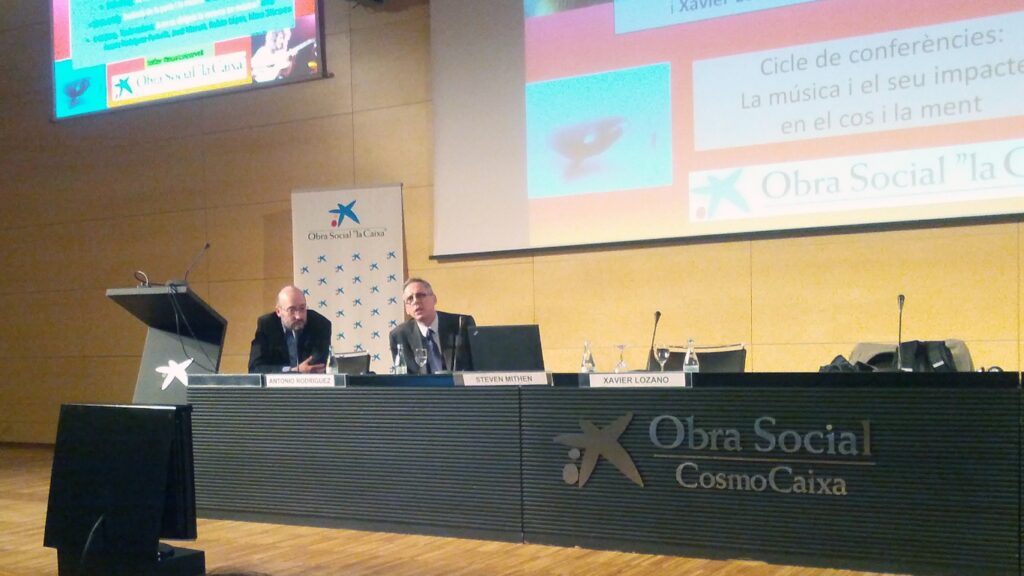The music is part of human nature, is “embedded in our DNA.” With this reflection Steven Mithen began his lecture “How Neanderthals sang? The origins of music”. The prestigious British anthropologist talked about music, language and brain in the Cosmocaixa auditorium, filled to the brim, within the series “The music and its impact on the body and mind, organized by the Obra Social La Caixa and IDIBELL. After Mithen conference, the musician and inventor of instruments Xavier Lozano fascinated the public with a demonstration that, with a little of imagination and talent, any object can be turned into a musical instrument.
Steven Mithen is the author, among others, of the book “The Singing Neanderthals”. During his speech in Barcelona, the specialist noted that the study of music is approached from various disciplines, as it is related to many aspects of the human being. For our species, music is so natural that probably existed long before the appearance of modern humans, conjectured the researcher. In fact, according to Mithen, “in recent years we have discovered that we are more similar to our ancestors than we thought”. For the archaeologist, Neanderthals and even earlier hominids could have been communicated in a quasi-musical manner.
Relationship Instrument
Mithen explained the evolution of language and music in humans in relation to the capacity of the brain, from the appearance of the first hominids, more than four million years to the present. The music appeared as an instrument of relationship and communication between individuals. The specialist explained that the language appeared between 200,000 to 70,000 years ago. Since then, music and words have followed different paths.
Monkeys and apes express in grunts, hoots and barks that have rhythm and even melody, and have a system of communication with certain rules and complexity. In the case of early hominids, the anatomical changes (increased oral capacity, in the case of Homo habilis and better breath control in Homo ergaster) provided a better oral expression. Muscle control necessary for bipedalism increased the expressive capacity of face and also body language and dance. Bipedalism was improved with rhythm and body movement, Mithen said.
Sexual role
Also sexual dimorphism was reduced, so that the difference in the size of the males and females was becoming less pronounced. This fact had consequences, such as loss of competition between males and increasing of female choice. “Music has a sexual role, to attract potential mates”, explained the researcher. Mithen also explained that singing and dancing seem to have an important role in establishing bonds of trust and in the process of socialization.
British archaeologist showed images of spaces in Neanderthal settlements, which could have held dances. The archaeologist made an example of Bilzingsleben site in Germany, of more than 300,000 years.
It seems that Homo neanderthalensis was almost identical to modern man. He had a big brain (larger than Homo sapiens’, in fact), a modern oral tract and sophisticated technology, practiced hunting and were well adapted to the environment. But the absence of symbolic artefacts remains and his cultural immobility suggest that they did not speak. Mithen defined Neanderthal communication as “holistic, multimodal, manipulative and musical”, which corresponds to the acronym “Hmmmm”, which would identify the common ancestor that gave room to music and language appearance.
Complex brain
“Singing is a very complex process that need a complex brain”, Mithen said. “Homo sapiens arrived in Europe from Africa 40,000 years ago. He developed a language that allowed him to create new ideas. Language allowed modern mind”, explained the British archaeologist. Mithen ventured that our ancestors might have disappeared because of the music. “Neanderthals language was overwhelmed by the language of modern humans”, he said.
Steven Mithen stressed the importance of music as a socializing element in all human cultures. The music, explained, is part of human behaviour from birth. Just think how babies are attracted to the music. “Children prefer to listen to songs with words”, Mithen says, and “we spoke to them with a high degree of musicality”.
Music from everyday objects
After the conference of Steven Mithen, Xavier Lozano took the stage. This musician and instrument inventor, known for his appearances in several television shows, surprised the audience by playing his music devices manufactured from everyday objects.
Thus, the Steven Mithen book cover became a flute, a macaroni and a piece of spaghetti, a whistle, and a bottle of soda, a flute. As if by magic, a metal ladder became a musical instrument, and a brick, a flute. A crutch, a folding chair, a watering can and even a construction fence picked up from the street were able to sound like the most delicate instruments. What was the secret of it all? Lozano is clear: “If there are holes, there is music”.

